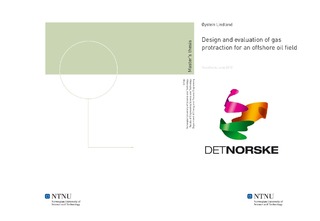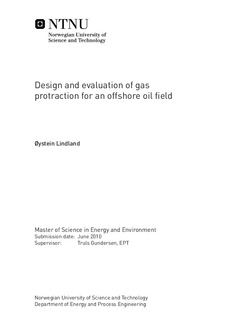| dc.description.abstract | Field A is a marginal oil field located in the North Sea, operated by Det norske oljeselskap ASA (hereby Det norske). Det norske are currently working on the maturation of the field development, and have identified three development options. Floating production, storage and offloading (FPSO), with a bridge link to a well head platform (WHP). Subsea tie-back to a host facility. Jack-up with production facility (JUDP) and WHP. Produced oil will be stored in a floating storage unit (FSU). The produced oil will be stabilized to the export specifications and offloaded to a shuttle tanker. The base case for gas export is to export wet gas to a platform on another field, Field B, where it will be dehydrated and conditioned to meet the export specifications in one of the export pipelines connected to the platform. There are however uncertainties concerning the processing suitability at Field B, and Det norske is therefore investigating the possibilities for installing dehydration and conditioning equipment on the Field A platform. In this thesis, different methods for dehydration and conditioning of the Field A gas is tested through process simulations in HYSYS. A mapping of the gas infrastructure in the Field A area reveals two dry gas export pipelines; Statpipe and Vesterled, and two rich gas export pipelines; FUKA and Sage. This thesis is mainly based on dry gas export, and therefore most of the work is put into export in Statpipe or Vesterled. A literature study concerning different methods to dehydrate and condition the gas is performed. The simulations later in the thesis are based on this study. To get a comparison basis for the different development alternatives in terms of weight, costs and complexity, a simulation of a basic Field A process with no dehydration or conditioning is first simulated. This will also be the Field A process if wet gas export to Field B is chosen as the solution for gas protraction at Field A. The basic process is then expanded with different equipment for dehydration of the gas, and the different dehydration processes are briefly evaluated. The dehydration processes are then varied and/or expanded to achieve both adequate dehydration and hydrocarbon dew point in the gas, based on the export specifications in Statpipe and Vesterled. The final processes, achieving both proper water- and hydrocarbon dew point in the export gas, are evaluated and compared to the basic process without dehydration and conditioning, in terms of weight, costs and complexity,. Based on the findings in this thesis it seems dry gas export from Field A is difficult to achieve. Based on the limited information available from the operating company of Field B, the Field B process is simulated in HYSYS to check the process suitability for the Field A gas. Finally, an alternative solution to achieve dry gas export from Field A, by bleeding off propane in the process, is briefly discussed. The solution of rich gas export in either FUKA or Sage is also briefly discussed. | nb_NO |

